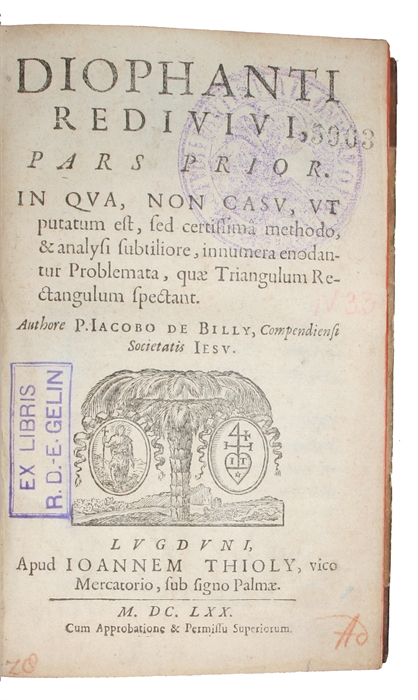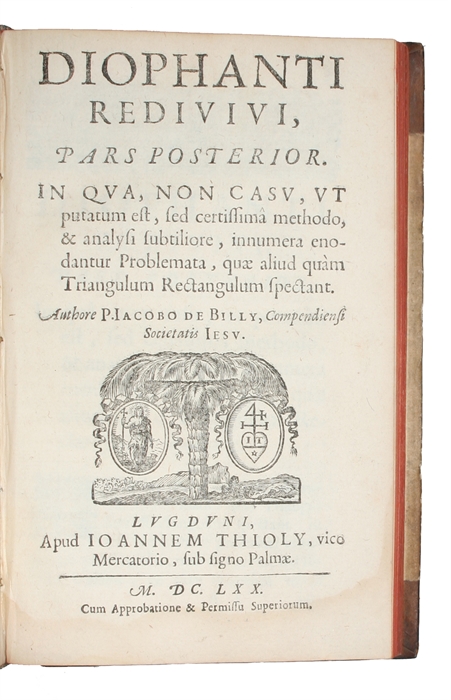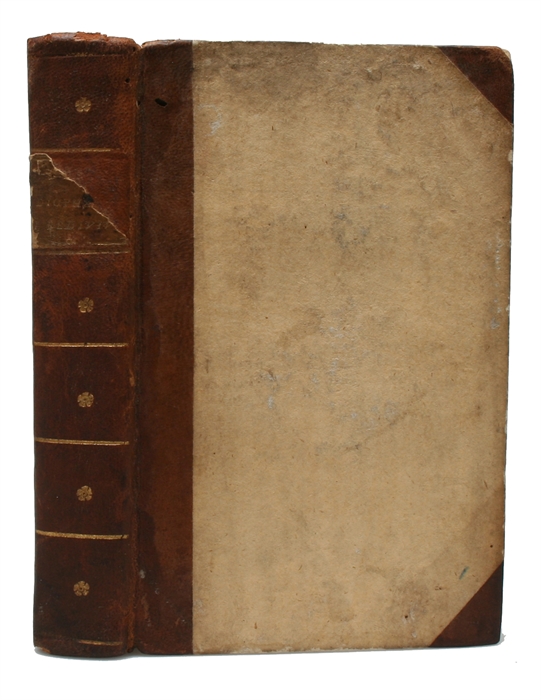FOUNDATIONAL WORK IN THE EARLY DEVELOPMENT OF NUMBER THEORY
BILLY, P. IACOBO de. [JACQUES de BILLY].
Diophanti Redividi, pars prior + posterior. In qua, non casu, ut putatum est, sed certissima methodo, &analysi subtiliore, innumera enodantur Problemata, quae (aliud quàm) Triangulum Rectangulum spectant.
Lugduni [Lyon], Apud Ioannem Thioly, 1670. 8vo. Contemporary half calf with simple gilding to spine. Gilt title-label to spine partly missing. Four tiny worm-holes to upper front hinge, just touching front free end-papers and nothing else. Minor edge-wear, but a nice, clean, and tight binding. Ex-libris stamps to title-page (one being R.D.-E. Gelin's, the other unlegible but probably a theological library). Mostly very faint marginal dampstaining to lower margin thorughout, not touching text. Neat old owner's name to inside of front board (Soldner). Without the two blank leaves between the end of the dedication and the beginning of the text (there is clearly no leaf with any text lacking; there is either a pagination-error, or there has been one or two blank leaves between the end of the dedication and the beginning of the work. In the other copies that we have been able to find collations of, there has been no leaf a4 nor A1 either - there is no doubt that the text is complete), and without the blank leaf after the end of Part One, but with two blanks at the end of Part Two. (8) pp., pp. 3-302; 140 pp. + two blank leaves.
Etremely scarce first edition of Jacques de Billy's mathematical magnum opus, known primarily as "Diophantus Redivivus" (i.e. "Diophantus Restored"), in which he gives some of the most important solutions to Diophantine problems, of which he was an expert. The work is highly important within the field of number theory and counts as one of the greatest testimonies to the early development of this branch of mathematics. The copy has belonged to the famous mathematician Johann Georg von Soldner (of the Soldner coordinate system).
It was partly due to the rediscovery of Diophantus in the 16th century that Fermat reached his famous "last theorem" in the middle of the 17th century, when reading Diphantus' "Arithmetica" and engaging himself with the problems presented here.
Jacques de Billy (1602-1679), a French Jesuit, who taught mathematics and theology and received the first professorship of mathematics at the Collège de Dijon, was highly interested in the problems that Diophantus had presented in his famous work, and some time before 1659, an active correspondence began between himself and Fermat, which led to, among other things, the his important "Diophantus Redivivus". The work includes many of Fermat's discoveries within the field as well as Billy's own take on them.
Before a professorship of mathematics had been created at the Collège de Dijon, the mathematical enthusiast Jacques de Billy was master of studies and professor of theology. His love for mathematics meant, however, that he taught the students privately, and one of the most eager students that he thus privately taught was Jacques Ozanan, in whom Billy instilled a profound love for calculus.
The only auction-records that we have been able to locate of the present work are that of Macclesfield (2004) and that of Honeyman (1978), both of which are without leaves between a3 and A2, thus lacking these two blanks (if they have ever been there). The Macclesfield-copy has the blank leaf after Part One and the two final blanks at the end of Part Two, but not the other (possible) blanks. The Honeyman-copy lacks all blank leaves, but only these, it seems.
Brunet I: 946, stating "Recherché et rare" (collation: 302 et 140 pp.). Not in Poggendorf, not in Graesse.
The previous owner Johann Georg von Soldner (1776-1833) was a famous German physicist, mathematician and astronomer, early on renowned for his great talent for mathematics (though almost completely self-taught). The Soldner coordinate system, which was in use until the middle of the 20th century in Germany, was named after him, as was the Ramaunajan-Soldner constant, but today he is probably primarily remembered for the final conclusion of light being diverted by heavenly bodies. It was Soldner that Einstein was accused of plagiarizing, when he calculated and published a value for the amount of gravitational light-bending in light skimming the Sun in 1911.
"Soldner was simple and reserved in manner, and he valued ral scholarship for its own sake. His painstaiking observational work on the detection of motion among fixed stars could be of value only to future generations of astronomers and illustrates the unselfish spirit of his work. His writings are clear and concise, and he avoided repetionon of what was already common knowledge." (D.S.B. XII:518).
Order-nr.: 42454



